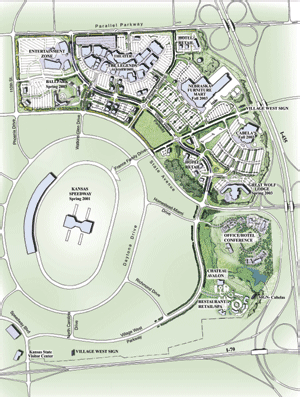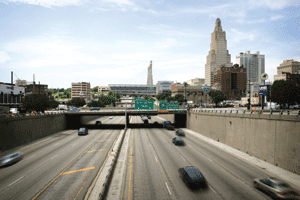For one thing, that development has helped pull Leavenworth, Lawrence and even Topeka into the metropolitan area. The challenge for these communities is how to transfer this energy by way of the highways. The Kansas Turnpike Authority decision to expand the Topeka–Lawrence leg to three lanes will help.
A development with the potential to create crossroads momentum is the $210 million expansion of U.S. Highway 59 from Ottawa to Lawrence. When completed in 2009, the road will emerge as a modern four-lane freeway. To this point, Lawrence has existed almost exclusively on an east-west axis. The university has kept it prosperous enough, but the highway alignment has largely limited growth to the east and the west. That will undoubtedly change.
For Ottawa, the completion of U.S. Highway 59 will be a mixed blessing as the southern end of the freeway will hook into I-35. Now the highway becomes Main Street as it passes through town. This, of course, promises growth for the area, especially around the area of intersection with I-35, but it may make the downtown less vital. Bottom line--U.S. Highway 59 has more potential to disrupt the culture of Ottawa than Lawrence. But then again, change is never easy.

Development at the "Liberty Triangle" at the crossroads of I-35 and 291 is currently under development. This region has all the makings to become a "lifestyle center", similar to one at Zona Rosa at the Intersection of I-29 and Barry Road.
Ottawa residents can look eastward to the parallel U.S. Highway 169. By widening the highway to four lanes to Paola and continuing south, the Kansas Department of Transportation has made the I-35 entry at151st Street in Olathe a significant crossroads. The full development effect along that route has yet to be felt, but it surely will be powerful in the years ahead. One can envision a veritable city springing up at the intersection of Kansas Highway 68 and U.S. Highway 169. The intersection of the more mature U.S. Highway 69 and Kansas Highway 68 several miles to the east gives a picture of what that development might look like.
The Big Picture For a variety of reasons, historical and geographical, Kansas City has emerged as a multi-crossroads city. As has been argued on these pages before, the largely unanticipated development of several of these new crossroads sites--the Village West complex in Kansas, the Bass Pro Shop development in Independence, Zona Rosa in Platte County, and potentially new developments in the "Triangle" area--has re-centered the metropolitan area around its traditional center, Downtown Kansas City.
Traditional urban planners bemoan the decentralization implicit in a multi-center metropolis. They also recognize that it makes fixed public transportation like light rail a virtual impossibility.
Nevertheless, this paradigm has some obvious advantages. For one, it causes traffic to flow away from the center during morning rush hour. Consider, for instance, just how many autos the new HCA hospital in Independence will pull eastward in the morning. By reversing the traffic flow at key times, the already auto-friendly Kansas City can remain that way without adding infrastructure.

All roads in the region merge in Downtown Kansas City-- literally at the nexus of North American trade.
What will help Kansas City remain even more congenial to the driver is the new Kansas City Scout, a sophisticated $43 million traffic management project. This 75-mile system will help area planners monitor traffic flow and report the same to drivers through electronic message boards and radio advisories. Kansas City is one of 25 cities in the country to receive the federal funding for this program.
A second, less obvious advantage to the multi-crossroads metro is that it will lessen the demands on any one area, most notably Downtown Kansas City. Built before the emergence of the automobile, the area inside the Downtown loop has a limited carrying capacity for automobile traffic. The fact that the IRS and the Federal Reserve are built outside the loop will also help prevent the area within the loop from collapsing like a dwarf star under the pressure.
For a variety of reasons, tradition and centrality among them, Downtown Kansas City seems to have emerged as the crossroad of crossroads in this multi-crossroads metropolis. This is a new role but a good one. Ideally, our urban planners will not just recognize it, but embrace it.
